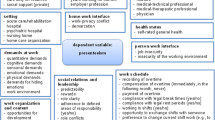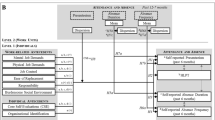Abstract
Objective
To examine the extent and relative value of presenteeism and absenteeism and work-related factors affecting them among health care professionals.
Methods
Physicians and nurses estimated their hours of absenteeism and presenteeism during the last 4 weeks due to health reasons, and how much their work capacity had been reduced during their presenteeism hours. Socio-economic background, factors related to work and work conditions and possible chronic and acute diseases were solicited.
Results
Presenteeism was more common but indicated lower monetary value than absenteeism. Job satisfaction explained the probability and magnitude of presenteeism, but not absenteeism. Experience of acute disease(s) during the study period of 4 weeks significantly predicted the probability of both presenteeism and absenteeism.
Conclusions
Experience of presenteeism seemed to be common among health care workers, and it had significant economic value, although not as significant as absenteeism had.
Similar content being viewed by others
References
Aronsson G, Gustafsson K (2005) Sickness presenteeism: prevalence, attendance-pressure factors, and an outline of a model for research. J Occup Environ Med 47:958–966
Aronsson G, Gustafsson K, Dallner M (2000) Sick but yet at work. An empirical study of sickness presenteeism. J Epidemiol Community Health 54:502–509
Beaton D, Bombardier C, Escorpizo R, Zhang W, Lacaille D, Boonen A, Osborne RH, Anis AH, Vibeke Strand C, Tugwell PS (2009) Measuring worker productivity: framework and measures. J Rheumatol 36:2100–2109
Berger ML, Howell R, Nicholson S, Sharda C (2003) Investing in healthy human capital. J Occup Environ Med 45:1213–1225
Bergström G, Bodin L, Hagberg J, Aronsson G, Josephson M (2009a) Sickness preseneteeism today, sickness absenteeism tomorrow? A prospective study on sickness presenteeism and future sickness absenteeism. J Occup Environ Med 51:629–638
Bergström G, Bodin L, Hagberg J, Lindh T, Aronsson G, Josephson M (2009b) Does sickness presenteeism have an impact on future general health? Int Arch Occup Environ Health 82:1179–1190
Böckerman P, Laukkanen E (2009) What makes you work when you are sick? Evidence from a survey of workers. Eur J Public Health 1–4
Boles M, Pelletier B, Lynch W (2004) The relationship between health risks and work productivity. J Occup Environ Med 46:737–745
Burton WN, Conti DJ, Chen C-Y, Schultz AB, Edington DW (1999) The role of health risk factors and disease on worker productivity. J Occup Environ Med 41:863–877
Burton WN, Conti DJ, Chen C-Y, Schultz AB, Edington DW (2002) The economic burden of lost productivity due to migraine headache: a specific worksite analysis. J Occup Environ Med 44:523–529
Burton WN, Pransky G, Conti DJ, Chen C-Y, Edington DW (2004) The association of medical conditions and presenteeism. J Occup Environ Med 46:S38–S45
Caverley N, Cunningham JB, MacGregor JN (2007) Sickness presenteeism, sickness absenteeism, and health following restructuring in a public service organization. J Manag Stud 44:304–319
Dew K, Keefe V, Small K (2005) ‘Choosing’ to work when sick: workplace presenteeism. Soc Sci Med 60:2273–2282
Donaldson C (2001) Eliciting patients’ values by use of ‘willingness to pay’: letting the theory drive the method. Health Expect 4:180–188
Elstad JI, Vabø M (2008) Job stress, sickness absence and sickness presenteeism in Nordic elderly care. Scand J Public Health 36:467–474
Escorpizo R, Bombardier C, Boonen A, Hazes JMW, Lacaille D, Strand V, Beaton D (2007) Worker productivity measures in arthritis. J Rheumatol 34:1372–1380
Forsyth M, Calnan M, Wall B (1999) Doctors as patients: postal survey examining consultants and general practitioners adherence to guidelines. Br Med J 319:605–608
Goetzel RZ, Long SR, Ozminkowski RJ, Hawkins K, Wang S, Lynch W (2004) Health, absence, disability, and presenteeism cost estimates of certain physical and mental health conditions affecting US employers. J Occup Environ Med 46(4):398–412
Hansen CD, Andersen JH (2008) Going ill to work–What personal circumstances, attitudes and work-related factors are associated with sickness presenteeism? Soc Sci Med 67:956–964
Hemp P (2004) Presenteeism: at work—but out of it. Harv Bus Rew October:49–58
Kessler RC, Ames M, Hymel PA et al (2004) Using the World Health Organization Health and Work Performance Questionnaire (HPQ) to evaluate the indirect workplace costs of illness. J Occup Environ Med 46:S23–S37
Kivimäki M, Head J, Ferrie JE, Hemingway H, Shipley MJ, Vahtera J, Marmot MG (2005) Working while ill as a risk factor for serious coronary events: the Whitehall II study. Am J Public Health 95:98–102
Koopmanschap M, Burdorf A, Jacob K, Meerding WJ, Brouwer W, Severens H (2005) Measuring productivity changes in economic evaluation. Setting the research agenda. Pharmacoeconomics 23(1):47–54
Lofland J, Pizzi L, Frick KD (2004) A review of health-related workplace productivity loss instruments. Pharmacoeconomics 22(3):165–184
Mattke S, Balakrishnan A, Bergamo G, Newberry SJ (2007) A review of methods to measure health-ralated productivity loss. Am J Manag Care 13:211–217
McKevitt C, Morgan M, Dundas R, Holland WW (1997) Sickness absence and ‘working through’ illness: a comparison of two professional groups. J Public Health Med 19(3):295–300
Pauly MV, Nicholson S, Polsky D, Berger ML, Sharda C (2008) Valuing reductions in on-the-job illness: ‘Presenteeism’ from managerial and economic perspectives Health Econ 17:469–485
Schultz AB, Edington DW (2007) Employee health and presenteeism: a systematic review. J Occup Rehabil 17:547–579
Schultz AB, Chen C-Y, Edington DW (2009) The cost and impact of health conditions on presenteeism to employers. Pharmacoeconomics 27:365–378
Stewart WF, Ricci JA, Chee E, Morganstein D (2003) Lost productive work time cost from health conditions in the United States: results from the American productivity audit. J Occup Environ Med 45:1234–1246
The Sainsbury Centre for Mental Health (2007) Mental health at work: developing the business case. Report No.: policy paper 8
Wynne-Jones G, Buck R, Varnava A, Phillips C, Main CJ (2009) Impacts on work absence and performance: what really matters? Occup Med 59:556–562
Acknowledgments
This study was supported by grants from the research funds of the Hospital District of Southwest Finland.
Conflict of interest
The authors declare that they have no conflict of interest.
Author information
Authors and Affiliations
Corresponding author
Rights and permissions
About this article
Cite this article
Rantanen, I., Tuominen, R. Relative magnitude of presenteeism and absenteeism and work-related factors affecting them among health care professionals. Int Arch Occup Environ Health 84, 225–230 (2011). https://doi.org/10.1007/s00420-010-0604-5
Received:
Accepted:
Published:
Issue Date:
DOI: https://doi.org/10.1007/s00420-010-0604-5




